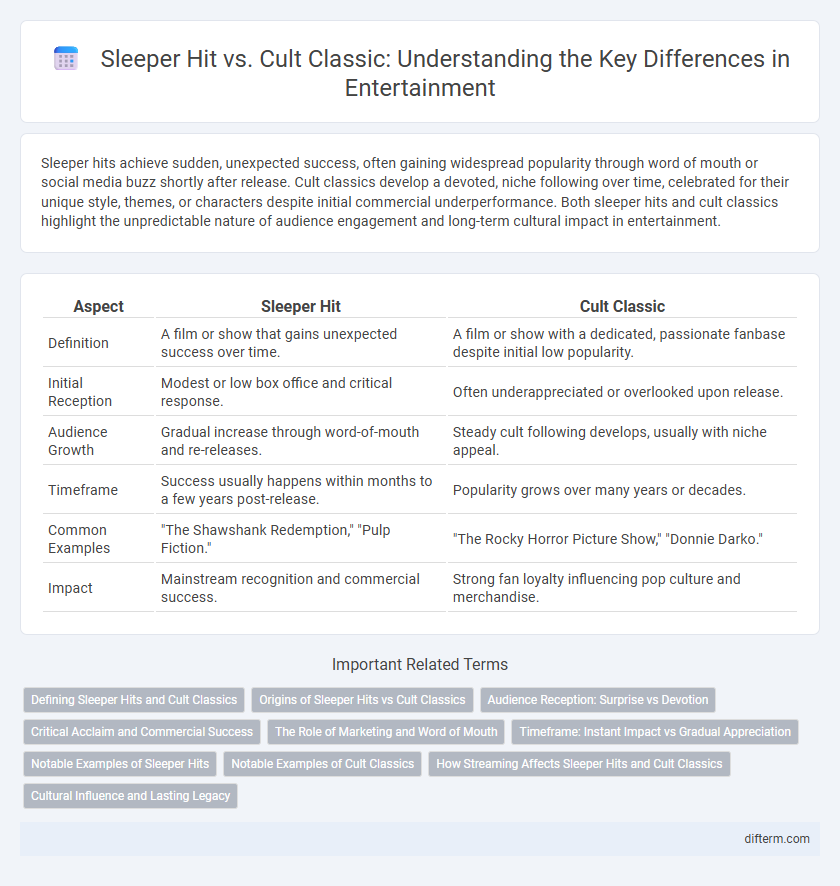Sleeper hits achieve sudden, unexpected success, often gaining widespread popularity through word of mouth or social media buzz shortly after release. Cult classics develop a devoted, niche following over time, celebrated for their unique style, themes, or characters despite initial commercial underperformance. Both sleeper hits and cult classics highlight the unpredictable nature of audience engagement and long-term cultural impact in entertainment.
Table of Comparison
| Aspect | Sleeper Hit | Cult Classic |
|---|---|---|
| Definition | A film or show that gains unexpected success over time. | A film or show with a dedicated, passionate fanbase despite initial low popularity. |
| Initial Reception | Modest or low box office and critical response. | Often underappreciated or overlooked upon release. |
| Audience Growth | Gradual increase through word-of-mouth and re-releases. | Steady cult following develops, usually with niche appeal. |
| Timeframe | Success usually happens within months to a few years post-release. | Popularity grows over many years or decades. |
| Common Examples | "The Shawshank Redemption," "Pulp Fiction." | "The Rocky Horror Picture Show," "Donnie Darko." |
| Impact | Mainstream recognition and commercial success. | Strong fan loyalty influencing pop culture and merchandise. |
Defining Sleeper Hits and Cult Classics
Sleeper hits are films or shows that achieve unexpected success over time, often starting with modest box office returns or limited viewership before gaining widespread popularity. Cult classics, by contrast, maintain a dedicated, passionate fanbase regardless of initial commercial performance, often characterized by unique or unconventional themes that resonate deeply with niche audiences. Both sleeper hits and cult classics demonstrate the lasting cultural impact of entertainment beyond mainstream blockbuster metrics.
Origins of Sleeper Hits vs Cult Classics
Sleeper hits originate from films, shows, or games that achieve unexpected success over time, often gaining popularity through word-of-mouth rather than initial marketing efforts. Cult classics typically emerge from niche audiences who passionately embrace a work despite limited mainstream recognition, with origins traced to distinctive, unconventional content or themes. Both sleeper hits and cult classics rely on unique audience engagement but differ in their paths to prominence and cultural impact.
Audience Reception: Surprise vs Devotion
Sleeper hits often gain audience reception through surprise, attracting viewers unexpectedly with strong word-of-mouth and gradually growing popularity despite initial low expectations. Cult classics, however, inspire deep devotion from a niche audience that passionately celebrates the work long after its release, often embracing unique or unconventional storytelling. These different patterns of audience engagement reflect how sleeper hits broaden appeal over time while cult classics maintain a dedicated, enduring fan base.
Critical Acclaim and Commercial Success
Sleeper hits defy initial box office expectations by gaining widespread commercial success and strong audience approval over time, often without immediate critical acclaim. Cult classics may not achieve significant commercial success upon release but develop a devoted fanbase and receive critical recognition in niche circles. Both categories highlight differing trajectories where commercial success and critical acclaim intersect uniquely in entertainment history.
The Role of Marketing and Word of Mouth
Sleeper hits often rely on minimal initial marketing budgets but explode in popularity through strong word of mouth and social media buzz, gradually reaching a wide audience. Cult classics typically develop dedicated fan bases over time, driven more by niche community engagement and sustained fan advocacy than by mainstream marketing efforts. The role of marketing in sleeper hits is to create initial awareness, while cult classics depend heavily on passionate word of mouth to maintain long-term cultural relevance.
Timeframe: Instant Impact vs Gradual Appreciation
A sleeper hit typically gains recognition and commercial success gradually over weeks or months, often through word-of-mouth and delayed audience discovery. In contrast, a cult classic achieves its dedicated fan base slowly over years, as appreciation intensifies through repeated viewings and cultural resonance despite initial underperformance. This distinction underscores how sleeper hits experience relatively rapid impact compared to the prolonged, organic growth characterizing cult classics.
Notable Examples of Sleeper Hits
Sleeper hits like "The Blair Witch Project," which grossed over $248 million worldwide on a $60,000 budget, and "Napoleon Dynamite," that developed a massive fanbase despite modest initial box office returns, showcase films gaining acclaim over time through word-of-mouth and cultural impact. These movies contrast with cult classics such as "The Rocky Horror Picture Show," which achieved iconic status through midnight screenings and dedicated fan participation rather than immediate commercial success. Sleeper hits often demonstrate strong longevity and mainstream breakthrough, driven by unique storytelling and audience resonance.
Notable Examples of Cult Classics
Notable examples of cult classics include films like "The Rocky Horror Picture Show," "Blade Runner," and "The Big Lebowski," which gained dedicated followings despite initial box office underperformance. These movies often feature unique storytelling, memorable characters, and quotable dialogue that resonate deeply with niche audiences. Unlike sleeper hits that gradually achieve mainstream success, cult classics maintain enduring popularity primarily through fan devotion and midnight screenings.
How Streaming Affects Sleeper Hits and Cult Classics
Streaming platforms have revolutionized how sleeper hits and cult classics gain recognition, enabling niche audiences to discover and share hidden gems far beyond traditional box office metrics. Algorithms tailored to viewer preferences increase the visibility of underrated films and series, often transforming obscure titles into widely celebrated classics over time. This digital accessibility also fosters community engagement and fan-driven content, solidifying the cultural status and long-term appeal of cult classics within the entertainment industry.
Cultural Influence and Lasting Legacy
Sleeper hits often achieve widespread popularity unexpectedly, influencing mainstream culture by introducing fresh trends and inspiring imitators across media platforms. Cult classics, however, cultivate devoted fanbases that sustain niche cultural significance through rituals, references, and community engagement over decades. Both contribute lasting legacies, but cult classics uniquely embed themselves in subcultural identity while sleeper hits reshape popular culture.
Sleeper hit vs cult classic Infographic

 difterm.com
difterm.com